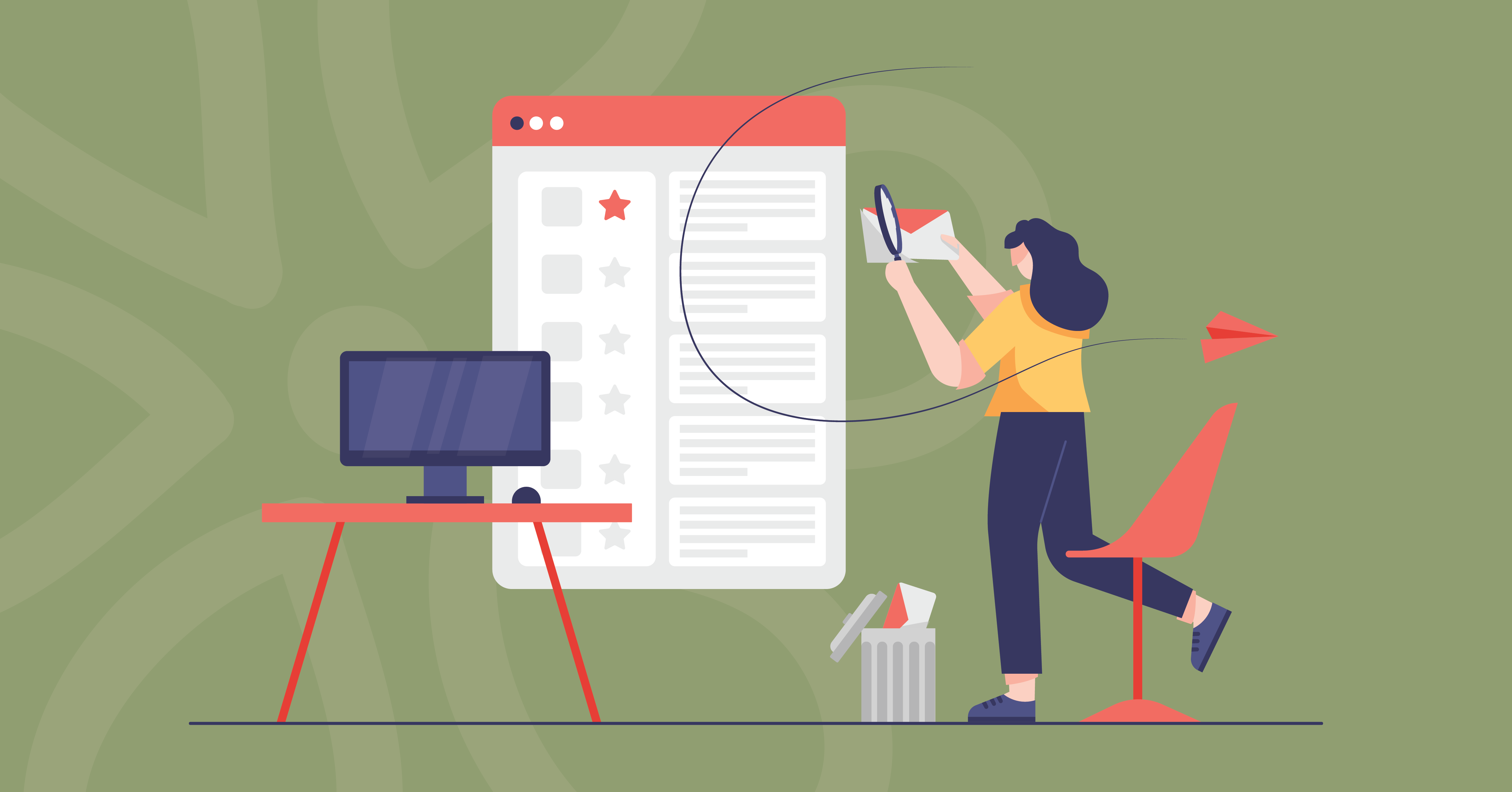Adding Customer Journey Mapping to Your Marketing Strategy
Customer journey mapping in marketing is a visual representation of the buyer’s journey. Learn the benefits of the marketing funnel and implementation tips.
A customer’s journey from awareness to loyalty is filled with hundreds of minute yet significant interactions with your business. Each point of connection gives your brand the opportunity to snag those new or return customers and shift them into loyal advocates. But those customer interactions also have the chance to turn your users away.
Until you can understand the entire customer journey, in all its non-linear and multidimensional glory, your brand can’t find the success you likely want. Fortunately, customer journey mapping gives you – and your entire team – access to data-driven, well-explored understandings of the customer experience that can help you generate the most streamlined, functional customer journey.
What Is Customer Journey Mapping in Marketing?
A customer journey map is generally formulated as a visual representation of the full customer lifecycle, including each distinct element within it. Often outlined as a 5+ stage process, customer journey mapping lets members of a brand, from marketing experts to sales teams and CEOs, readily understand each stage of the customer journey.
The process of customer journey mapping focuses on the idea that the complete customer lifecycle should be placed in the spotlight of marketing strategy. By analyzing each specific point of the journey – from touchpoints and end goals to the emotions behind customer actions – brands can develop a strategy that both satisfies current customer needs and extends onward to acquire new user bases.
Benefits of Customer Journey Mapping for Your Business
The entry point to success begins and ends with the customer. Undeniably, it’s not enough to have spectacular products or services; you have to also focus efforts on developing a sense of what your customer needs, wants, and looks for.
Customer journey mapping gives you access to that data, much of which is already at your fingertips. But it takes it a step further by giving you the option to conceptualize the data into a format that makes sense to you and your team. The aspect of visualization makes it easy to understand complex ideas and find real-life applications and solutions. Along with those, customer journey mapping offers a few other benefits as well:
1. Enabling Better Customer Experiences
Crafting a precise customer journey map can, unsurprisingly, offer benefits to your customers’ experience. Every customer touchpoint is an opportunity for you or your brand to review and improve. The evaluative process means that you can find places for growth all along the customer journey, rather than focusing only on how your strategy benefits potential customers.
2. Improving Customer Retention
One of the main benefits of customer journey mapping is its application throughout the customer funnel. Users are more likely to reach a point of loyalty when they’ve been engaged throughout the earlier points of the process. By understanding and meeting opportunities to promote customer satisfaction throughout the funnel, your brand can more easily move past the awareness stage and towards the end goal: customer retention.
3. Reaching New Target Audiences
Customer strategy doesn’t just benefit current customers or even those within your current understanding of your target audience. Visualizing the complete customer journey can help you notice areas where new customers might engage. It offers the chance to catch customer behaviors you might not have seen before and choose to follow those for a fuller understanding of who your user base is.
4. Promoting Data-Driven Results
Like any quality approach to marketing, customer journey mapping relies on well-researched metrics and decisions. Customer journey mapping is particularly beneficial in this regard because it requires careful research and applies those findings to a visual roadmap. Evaluating your data becomes that much easier when you’re looking at it through a palatable format, which then leads to educated results.
Elements of Successful Customer Journey Mapping
The customer journey map looks different for every brand, but using the following elements as a template can help you make sure you don’t miss any crucial components.
Reaching Each Stage of the Marketing Funnel
Your customer journey map should envelop each stage of the sales funnel. Whether your ecommerce brand needs to focus its efforts on first-time customers or upping the conversion rate, your customer journey map should touch on each customer segment to find areas for growth all along the path.
Buyer Personas
The detailed representation of buyer personas is useful for so many things, and it comes in handy again with customer journey mapping. Well-researched and regularly updated buyer personas include the customer’s point of view that you may not get otherwise. When you add these to your customer journey map, you take it from simple statistics to a detailed narrative that helps you better serve users.
Touchpoints
Touchpoints are moments when your users interact with your brand. At any given touchpoint, a customer forms an opinion about your brand. Each stage of the journey has its own touchpoints, from seeing a TikTok ad to opening a newsletter to getting a request for a post-purchase review. Valuing every touchpoint for what it adds or takes away from the customer experience is an essential understanding to include in your map.
User Goals & Emotions
Within your research into buyer personas and customer touchpoints, user end goals and emotions are typically covered, but it’s important to thoroughly outline them as points on their own. User goals are closely tied to their emotions, which are linked to action points, and it’s your job to decipher those goals and find out how you can help them be reached.
Pain Points
Like customer emotions and goals, pain points are a part of the customer experience that greatly informs your customer journey map – and your strategy for serving your users. Pain points are the cause of negative emotions your customer feels throughout the buying process. They happen when a problem occurs during that experience. Pain points can happen at any moment during the customer lifecycle, from onboarding to the post-purchase experience, and they can impact your business no matter their location.
Tips for Customer Journey Marketing
Customer journey marketing doesn’t have to be intimidating. Follow these tips to avoid common slip-ups we see brands falling victim to.
Marry Your Customer Journey Mapping and Marketing Efforts
Analyzing the customer journey can’t be done in a vacuum. Your customer journey map should, like any other marketing tool, be performed with other marketing efforts highly involved. Use each to inform the other for the most benefit.
Another major benefit of customer journey mapping is that it gives you a resource to use across your organization that details that information. Utilize the resource by making sure every part of your team – not just your marketing team – understands the complete customer journey and the part they play in improving it.
Utilize Your Research
Again, data-driven practices are part of what makes mapping the buyer’s journey so effective. Customer journey analytics typically includes the use of detailed buyer personas, thought-out touchpoints, and customer feedback:
- Personas: As described above, customer personas should include more than just demographics. They’re a chance for you to investigate who your customer is: what they want, need, and experience in and out of their journey with your brand.
- Touchpoints: These should include actions you already know your users are performing, from seeing your brand on social media or looking for you via a Google search to making a purchase. By adding touchpoints based on your data or research, you ensure that any areas for improvement – and the solutions you make for them – tell the whole story.
- Surveys and Reviews: Whether it’s a survey about new products, a review that explains their purchase decision, or something else, your customer feedback is one of the most valuable forms of data to include in your customer journey map.
Work in Measured Results
Similarly, you should use your research within each step of your mapping process. Defining objectives, assessing areas to explore the life cycle further, and modifying your strategy should all work from your data on what results will perform. As you evaluate and review, the success of your results should be measured by the same data, leaving no room for uneducated objectives.
Personally Explore the Customer Journey
There’s no better way to understand the customer perspective than to experience it for yourself. Whether you are a brand owner or a marketing team member, you can take the trip through the customer funnel to gain an accurate understanding of what it looks like from the other side.
Not only can this help you develop a more realistic visualization, but it can also help you find the sticking points where customers will exit the funnel – and find solutions that you can actually employ. As you take the customer journey yourself, remember that it is not a quick trip down the funnel with no hiccups. It’s dynamic and seldom follows a straight line. Try to imagine the challenges users face during the process to find a more accurate vision.
Update and Review
No marketing process is ever complete. The never-ending cycle of review, reevaluation, and adaptation is as enlightening as it is vital. When it comes to customer journey marketing, the story is no different. Every aspect of business is constantly changing: digital marketing evolves quickly over time, customer interest is never stagnant, and the needs of your business are just as dynamic as they are. To use customer journey mapping most effectively, remember that it can’t be a singular action but rather a tool you can employ throughout your business’s lifetime.
Conclusion
Customer journey mapping is just one leg of a complete marketing strategy – but it is an important one. Your customers are the most essential piece of the puzzle, and designing a strategy that unites data, emotion, and experience can help you reach new heights.
Working with experts in the field of customer connection can help take your marketing even further. At First Media, we’ve been in the world of decisive customer-focused strategy long enough to develop systematic approaches that work. With data-driven customer prospecting, full-throttle targeting tactics, extensive customer insights, and AI technology like our Comments Analysis Tool, you get access to more than just a curated audience of millions – though you get that too.





